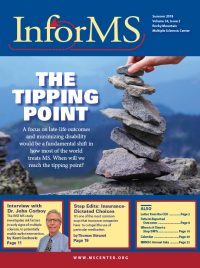As we develop treatment strategies that rely on early diagnosis, it’s more important than ever that we identify MS as quickly as possible — and that means watching for common factors that we see in early MS, and looking at things that may be reliable indicators of what could develop into the disease.
The RISE MS study — named for “RISk factors in Early MS” — is looking into these earliest indicators. Common symptoms and biomarkers that can be detected long before what we’d traditionally see as MS symptoms could give doctors a leg-up on early and effective treatments. We recently talked to Dr. John Corboy, Co-Director of the RMMSC at CU, to get more details about this important study.
RMMSC: Please tell us about the background and impetus behind the RISE MS research study.
Dr. Corboy: With the RISE MS study, we are investigating whether we can identify risk factors that are associated with very early signs of multiple sclerosis, to potentially enable intervention as early as possible prior to clinical manifestations.
We believe this work is important because we now know that MS starts long before we see clinical manifestations, such as optic neuritis or numbness on your right side. There is emerging data that suggests there are early indications of MS which manifest in various ways. These early manifestations include decreased levels of activity, increased use of health care resources, and decreased cognitive function.
For example, the manifestation of earlier decreased cognitive functioning has been shown in several different studies. In one study, researchers looked at mandatory standardized tests taken by high school students in Norway. They looked at individuals who eventually developed MS and compared them to people that didn’t develop MS. When you look back at the tests results of people who developed MS, they didn’t do as well on the test compared to the people who didn’t develop MS.
And finally, there are a number of studies that show that people that are asymptomatic and who get MRI scans for other reasons may already have MRI lesions suggestive of MS, and this is referred to as Radiologically Isolated Syndrome. If you follow these individuals over time, they develop symptoms consistent with MS at about the same rate as those who already have had a typical first attack of MS. These individuals also already have smaller brain volumes compared to people that who are matched by age and sex, suggesting that loss of brain volume as is typically seen in MS begins even before the first overt signs of the disease.
This body of research suggests that something is going on, even before clinical symptomatology of MS. And it argues even further that it is very important to identify people as early as possible to enable the most effective treatment possible.
RMMSC: What are some of the early risk factors of MS that we already know about?
Dr. Corboy: Adolescent or post-adolescent obesity, smoking, and Vitamin D deficiency have all been identified as early risk factors. These are things that are potentially alterable. Through this study, we may identify additional early risk factors that are alterable. And there are also probably some things that are not alterable like various genes. With the RISE MS Study we are trying to understand what factors — both alterable and not alterable — are associated with the earliest signs of MS.
RMMSC: How is the RISE MS study designed and what makes it unique?
Dr. Corboy: First, we will use the MRI scan as the marker of earliest signs of MS, because it is quite clear that the MRI scan is abnormal before people have their first clinical attacks. If you look at the MRI scans when people have their first clinical attacks, the average number of lesions on the scans is 15 to 35. Those lesions did not all happen instantaneously the week before their MRI scan was done. There are similar studies that are being done where people are using clinical MS as the outcome. But with these studies, the average age is going to be 30, and there is a whole group that has already developed MS by then.
The second thing that makes the study design unique is that we are looking at people who are known to be at highest risk — first degree relatives of MS patients. We are picking people intentionally who are at a higher risk because we know that we will be able to have a higher number of people who will have an abnormal MRI scan.
Thus, we will be looking at this highly at-risk population and using the most sensitive measure, an MRI scan, to try to identify what other factors are associated with changes seen on an MRI scan. We will look at several different factors: Genetic markers (mutations in specific genes), immunological markers, and markers of damage to nerves.
In addition, importantly, we also have the benefit of the lead epidemiologist in the DAISY Study (the Diabetes Auto Immunity Study in the Young), Jill Norris, who has worked with and developed environmental screens focused on exposures, eating behaviors, activities and a variety of other things that are potentially related to risk factors in developing chronic conditions.
RMMSC: What will participation in this study involve for fi rst-degree relatives of MS patients?
Dr. Corboy: The study will involve one MRI, blood tests, and environmental questionnaires. Our intent is to use the preliminary information to develop a longitudinal study where people will
be followed over time. Eventually, we could foresee that people will enter the study, then get a repeat MRI scan every two years, and perhaps every 6-12 months we might do an update on their environmental screen and do more blood testing. The blood will not only be used for this study — additional blood will be stored in various formats so researchers can look at different types of cells and we can examine this data set in various ways in the future.
RMMSC: How might this body of research evolve over time?
Dr. Corboy: Starting this study gives us the opportunity to develop data so we can seek grants to allow us to turn it into a longitudinal and multi-center study including patients from different states and countries.
Indeed, eventually conducting this study longitudinally would be extremely important. We know that the median age of onset of MS clinically is about 30. And that means that 50 percent of people are diagnosed with their first attack before 30 and 50 percent are diagnosed after age 30. We don’t know when these fi rst signs occurred, and they may be different for different people, so looking at changes over time is key. It is also conceivable that we will identify individuals who are at risk of developing MS already have lesions consistent with MS. Studies show that roughly 10% of first degree relatives have abnormalities typical of MS on their MRI scan and are asymptomatic.
There is a possibility that many of these people will never develop clinical signs of MS. So, one other significant potential outcome from this is that we may be able to identify markers, such as gene markers or other markers, which predispose people to a benign version of MS.
Fundamentally, the research could evolve to help us understand one of the big questions in the MS world: How do we distinguish those who are likely to go on to have bad MS that we really want to treat aggressively from the onset and those who have a benign version, who may not need to be treated at all?
Right now, we have no good way of distinguishing that. We may well define that there are significant numbers of people who have signs on their scan and — if we are eventually able to set this up as a longitudinal study — might never develop significant signs of clinical MS. Who are these individuals? What are their markers? How would we distinguish them and how could we further refi ne and tailor the way we treat individual MS patients in the most effective way possible?
RMMSC: What could answering those questions mean for MS patients and their families?
Dr. Corboy: If we were able to develop a small screen for MS — potentially with an environmental screen and one or two blood tests, not an expensive MRI scan — that would be quite a useful tool to use with people at medium to high risk of developing MS. It could allow us to make a potentially faster and earlier diagnosis and potentially identify people that would be appropriate to even treat.
RMMSC: What questions do you think may arise when it comes to potentially developing a screening tool of some sort?
Dr. Corboy: I think about the connections between this research and the questions that have emerged in the breast cancer arena. Now, to be clear, breast cancer is much more common than MS so these are certainly different arenas – about 12% of women may develop breast cancer in their lifetime. However, there is an interesting corollary to consider.
With increased screening for breast cancer, the question has arisen: are we simply identifying more women with relatively less severe forms of breast cancer. There is an open question in the cancer world as to how aggressively to treat those individuals, and we have the same potential issue here. Since this research could eventually lead to the possibility of developing a screening test, we’ll need to ask important questions around how and when to screen people.
RMMSC: Looking at the big picture and the broad landscape of MS research over the last 30 years, how will this study add to our growing body of knowledge?
Dr. Corboy: Over the past 30 years, our understanding of this disease has improved greatly and fostered the development of disease modifying therapies to inhibit the immune attack of MS. We know that diagnosing the disease early, and beginning treatment quickly is key to impacting the course of the disease and achieving the best possible outcomes for patients. This study will give us critical insight into understanding what is occurring prior to an overt clinical manifestation of MS.
Understanding that will allow us to diagnose MS earlier, faster, and use our treatment approaches even more effectively.



